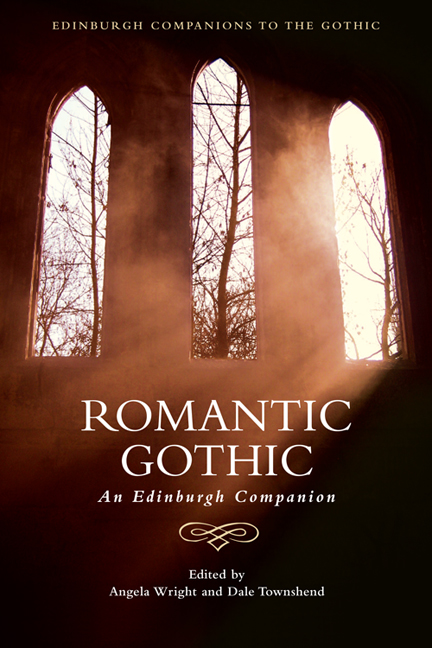Book contents
- Frontmatter
- Contents
- 1 Gothic and Romantic: An Historical Overview
- Part I Gothic Modes and Forms
- Part II National and International Borders
- 11 Gothic Borders: Scotland, Ireland and Wales
- 12 Gothic Travels
- 13 The Romantic and the Gothic in Europe: The Elementary Spirits in France and Germany as a Vehicle for the Transmission and Development of the Fantastique, 1772–1835
- 14 American Gothic Passages
- Part III Reading the Romantic Gothic
- Notes on Contributors
- Index
11 - Gothic Borders: Scotland, Ireland and Wales
from Part II - National and International Borders
Published online by Cambridge University Press: 05 August 2016
- Frontmatter
- Contents
- 1 Gothic and Romantic: An Historical Overview
- Part I Gothic Modes and Forms
- Part II National and International Borders
- 11 Gothic Borders: Scotland, Ireland and Wales
- 12 Gothic Travels
- 13 The Romantic and the Gothic in Europe: The Elementary Spirits in France and Germany as a Vehicle for the Transmission and Development of the Fantastique, 1772–1835
- 14 American Gothic Passages
- Part III Reading the Romantic Gothic
- Notes on Contributors
- Index
Summary
By the Romantic period, the idea of an ‘imagined community’ or shared national identity for Britain had come under intense pressure due to an increasingly complex nexus of national relationships both at home and abroad. In the wake of the Acts of Union which had brought England together with Wales (1536), Scotland (1707), and Ireland (1800, 1801), the ongoing tensions and rivalries of the four nations as a newly united Britain made it desirable to preserve their distinctive national identities, vernaculars and homespun traditions even as they were formally united. Whether one subscribed to Enlightenment models of stadial theory (according to which civilisation progressed in stages), or welcomed the subversive implications of an atavistic past for the present day, Britain's historical vicissitudes and her cultural ancestry held a new fascination in the midst of the uneasy building of a collective national identity for the four nations. The American and French Revolutions and the debates to which they gave rise, Britain's war with France, and the Napoleonic wars further contributed to the emergence of a new modern Britain (Colley 1992). In this context, the Gothic mode, which readily lent itself to the exploration of anxieties about ‘otherness’, nationhood, sociopolitical organisation, suppressed histories and the breaking of ethical and ideological boundaries, provided a multitude of ways for authors and their audiences to navigate a volatile domestic terrain, imaginatively crossing national borders, opening up liminal spaces, and exploring key moments of historical transition and their long-term ramifications. Instead of displacing villainous antagonists onto Catholic Europe (mainly France, Italy and Spain) as prominent Gothic novelists including Horace Walpole, Ann Radcliffe and Matthew Lewis tended to, many authors found fresh inspiration by mining their own national histories in order to address the troubling legacies of the past and their implications for the future.
This chapter examines some of the ways in which writers from all sides of the British borders responded to the wider shifting of national identities through their imaginative and sometimes provocative appropriations of Gothic topoi, from the revival of ghostly Bards in the poetry of the unsettled post-Enlightenment and pre-Romantic era, to some of the most subversive and disturbing examples of doubling, splitting, incarceration and the effacement of individual and national identities in Gothic fiction of the 1820s.
- Type
- Chapter
- Information
- Romantic GothicAn Edinburgh Companion, pp. 207 - 223Publisher: Edinburgh University PressPrint publication year: 2015



